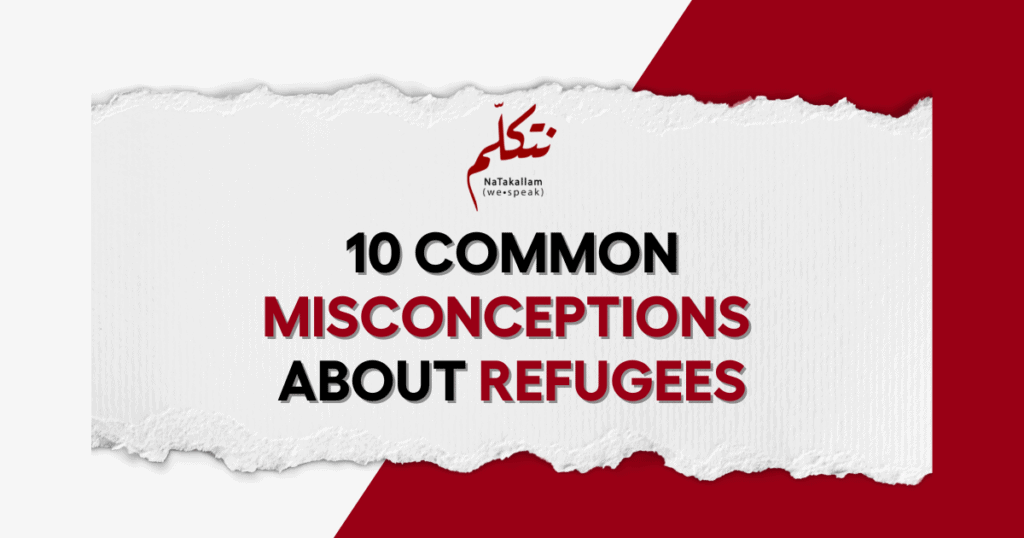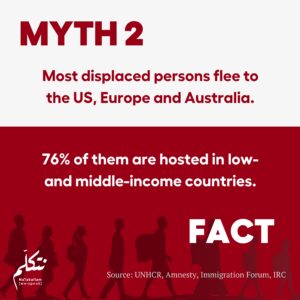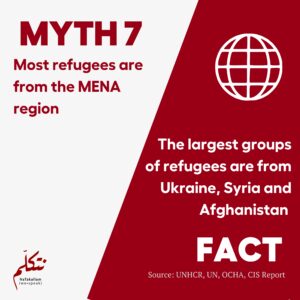
Courage In The Impossible: Gaza’s Poets Speak
Amidst Gaza’s turmoil, poets’ voices resonate. Explore Palestinian poetry’s power and resilience.



Resettlement is still a rare phenomenon, even though millions are eligible. In 2020, resettlement numbers hit a record low in the past two decades, according to a UNHCR report. Even though the US increased their refugee ceiling in 2021 to 62,500, a total of only 11,411 were resettled in the fiscal year – a mere 18% of the announced target. Even if successful, the resettlement process often takes years, and the journey of starting life anew in a foreign country can be extremely hard, especially in the face of new legal and educational systems, foreign languages, and cultural norms.
NaTakallam works with skilled refugees who are often stuck in limbo, cut off from local labor markets, in camps or other transit circumstances. Therefore, each language session with NaTakallam makes important and meaningful contributions to their livelihoods and overall sense of belonging.
Sources: UN, UNHCR (Report), UNHCR (Data finder), Immigration Forum.

Contrary to common belief and misleading headlines, only a small fraction of resettled refugees are hosted in developed countries of the West. From the 108.4 million forcibly displaced people today, the US admitted just over 25,000 refugees in 2022, using only 20% of the admissions target set by the Biden administration. In 2022, the EU resettled only 16,695 refugees despite promising to resettle more than 20,000 refugees. Most are forced into limbo states, with no legal residency or work status.
The majority of displaced persons that NaTakallam works with have fled to neighboring developing countries. As of mid-2022, the leading host countries include Turkey (3.6 million refugees), Iran (3.4 million), Colombia (2.5 million), Germany (2.1 million) and Pakistan (1.7 million). Together, they accommodate 38% of the global refugee population.
Sources: UNHCR, Amnesty, Immigration Forum, CBC News, International Rescue Committee

Not all refugees are adults. According to the UNHCR, an estimated 36.5 million of the world’s 100 million displaced people are under the age of 18. Furthermore, an estimated 12.5 million of the 27.1 million refugees are child refugees. Between 2018 and 2020, an average of between 290,000 and 340,000 children were born into a refugee life per year. Today, there are over 1 million children in the world who were born as refugees.
This demographic breakdown holds true for almost every regional crisis. Though children make up about a third of the global population, they constitute 50% of the world’s refugees. This dynamic is a significant concern, as contemporary child migration is often inhumane, unregulated, and dangerous. Moreover, an additional obstacle for refugee children seeking asylum is the fact that many of them go through this process without adult support.
Source(s): UNHCR, UNICEF, Concern USA, UN News

For refugees, smartphones provide access to essential and potentially life-saving information. Smartphones are used to find food, shelter, and assistance, navigate new areas, communicate with loved ones, and even earn a living through virtual work. Refugees often spend up to a third of their disposable income to afford connectivity and opportunities that come with a smartphone, according to Amnesty International.
In the era of what some have dubbed “the connected refugee,” NaTakallam provides opportunities for refugees to work as online language tutors, interpreters, and translators for users worldwide.
Sources: UNHCR, Forbes, GSMA, Amnesty

Contrary to the frequent images of sprawling refugee camps in the media, almost 80% of refugees live in urban areas. This has presented a new set of challenges: resources are often less concentrated and humanitarian assistance is less plentiful, meaning that individuals can miss vital information and aid more easily.
NaTakallam works with displaced persons in both urban areas and refugee camps to ensure no one is marginalized due to their current circumstances. We leverage technology in a way that ensures accessibility for all users.
Sources: UN Refugees, UNHCR, The Brookings Institute

The notion that admitting refugees will ruin a host country’s economy is rooted in false economic beliefs. Over time, it has been shown that refugees actually add more value to the economy than the initial cost of resettlement – if they are granted the right to work legally. Moreover, studies show that low-skilled foreign workers and low-skilled domestic workers tend to complement each other rather than compete. In the US, refugees add billions to the economy, and experts assert that they will play a vital role in helping economies recover after the pandemic.
What is more, contrary to political narratives, studies consistently show that refugees are less likely to commit crimes, engage in “antisocial” behavior, or be arrested. In fact, higher immigration is generally associated with much lower crime rates.
Many of NaTakallam’s displaced tutors are barred from local employment due to legal restrictions – leaving them vulnerable to the black market and unsafe work. NaTakallam allows refugees to make an income legitimately and safely, regardless of their location.
Sources: Immigration Forum, University of Oxford, Business Insider, Economic Research Forum, Global Citizen

While the news is often inundated with talk about refugees from the Middle East and North Africa region, over 72% of refugees arriving in the United States are actually not from the MENA region. As of 2022, the conflict and humanitarian crisis in Ukraine has forced more than 8.2 million people to flee the country with 5.9 million internally displaced. Followed by 5.4 million Syrian refugees hosted within the MENA region, with over 6.8 million internally displaced, and 5.2 million refugees from Afghanistan, of which 47% are children, and 3.3 million internally displaced. Furthermore, countries such as Venezuela, Burkina Faso, Myanmar, and Eritrea, among many more, are grappling with conflict and displacement issues, yet are frequently overlooked.
Sources: UNHCR, UNHCR Syria, UNHCR Afghanistan, UNHCR Ukraine, Statista, NRC

Popular narratives paint refugees as “economic migrants” who come to profit from the opportunities of more developed countries and never return to their home countries. This is a misconception. According to various surveys done across the world, most refugees are understandably reluctant to go home when the situation remains unsafe. However, from a sample survey of 1,100 displaced Syrians, an overwhelming majority, around 73%, say they would return home if the conditions were right.
Another report showed that in 2019 alone, 46,500 refugees voluntarily returned to the Central African Republic. What refugees seek is physical safety, dependable work, and sustainable housing, and the majority agree that if this were available in their home country, they would return. NaTakallam enables refugees to have reliable, consistent work as language tutors and translators in Arabic, Armenian, English, French, Kurdish, Persian, Russian, Spanish, Ukrainian and more.
Sources: UN refugee statistics, Washington Post, Relief Web, The National, UNHCR report

Employers say it best: when it comes to refugees, “they come to work and get the job done.” Research from the Fiscal Policy Institute (FPI) in 2018 highlights that in addition to being hardworking, refugees often stay with their employers for longer and speak a foreign language – a highly desirable skill for any global company.
Furthermore, in a Tent Partnership for Refugees report (also backed by the FPI), many businesses that hired refugees stated that they were among their most dedicated workers. Employee turnover rates were much lower among refugee employees than in the general population – thus, saving businesses money.
Sources: UN, Fiscal Policy Institute, Business Insider, Tent Partnership for Refugees.

Everyone can do something. Whether it is welcoming refugees into your own community, raising awareness about the cause, or supporting refugee-centered organizations, you have the power to make an impact beyond donations.
And if you are looking to support refugee livelihoods directly, amidst the fastest-growing displacement crisis of our time, consider bringing NaTakallam into your home, classroom, or office setting for your language-learning, cultural exchange, or translation needs. Change a life, one refugee at a time.
Reimagine your language journey with NaTakallam.
Try a session in Arabic, Armenian, English, French, Kurdish, Persian or Spanish.
Languages open doors and minds. Discover new worlds.
Learn Arabic, Armenian, English, French, Kurdish, Persian or Spanish.
Deep dive into a language, packed with culture. Personalized to you.
Choose from Arabic, Armenian, English, French, Kurdish, Persian or Spanish.
Deep dive into a language, packed with culture. Personalized to you.
Choose from Arabic, Armenian, English, French, Kurdish, Persian or Spanish.
You might also LiKe

Amidst Gaza’s turmoil, poets’ voices resonate. Explore Palestinian poetry’s power and resilience.

Since the start of the ongoing Mahsa Amini Protests, we’ve heard the slogan “Woman, Life, Freedom” travel around the world. In Persian this is “zan, zendegî, âzâdî” (زن, زندگی, آزادی), but the slogan originates in the Kurdish language and the Kurdish struggle for autonomy.

A smattering of French slang from around the world! Learn more expressions like this with NaTakallam’s native speaking tutors.

Spanish is one of the fastest growing foreign languages in the world. Get access to the Spanish business world with our native tutors – tailored to your needs.
Improve your proficiency in Farsi or Dari & contextualize your learning with cultural insights from our native tutors. Language & culture go hand-in-hand at NaTakallam.
Looking to do business with Kurdish businesses? Learn with NaTakallam’s native speakers & reach new language (& business) goals – tailored to your professional needs.
Gain an edge with contextualized French learning by native tutors from displaced backgrounds. Flexible, with cultural & business insights, tailored to your needs.
Choose from Eastern Armenian or Western Armenian. Get quality teaching & unique insights from native tutors. Gain an edge with Armenian language skills.
Offer your team a smoother integration or transition with our customized English lessons delivered by bilingual tutors with extensive English instruction experience.
Choose from Modern Standard Arabic or any of our 7+ dialects offered by native tutors across the region. Take your proficiency to the next level & connect with the Arab business world.